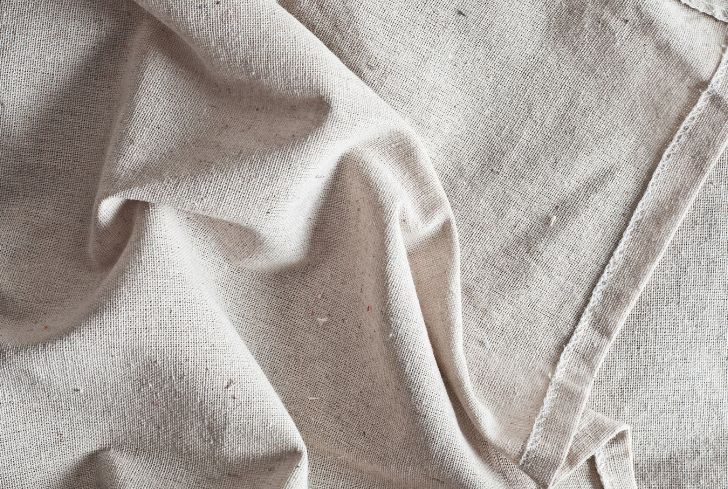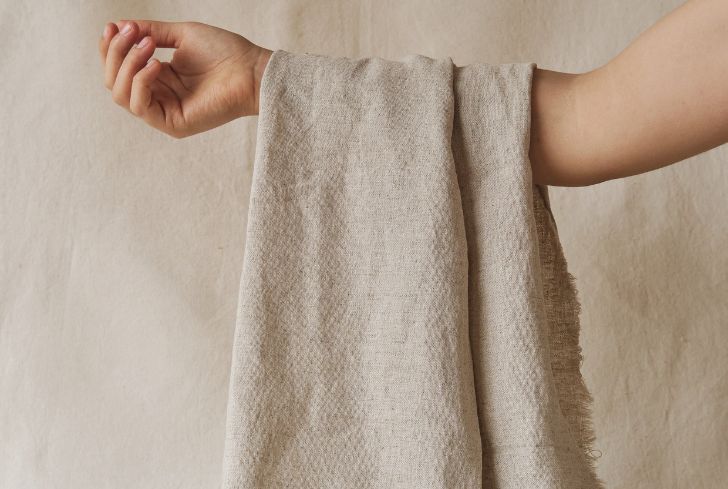Linen has been around for thousands of years. It is one of the oldest materials worldwide. There are many reasons why alternatives have failed to replace linen, and we will discuss them in this blog post.
Is linen biodegradable? The short answer is yes because it is made from a natural resource – the fibers of a flax plant. Therefore, it qualifies as organic matter and will consequently break down fast.
Linen is a fashionable material that you can use in other areas apart from the clothing industry. To learn more about linen, keep reading. You will discover its composition, how long it takes for decomposition, and how you can safely dispose of linen.
Is Linen Biodegradable?
Yes, linen is biodegradable, but the extent depends on the manufacturers’ additional ingredients. If the fabric has been dyed, it may no longer be capable of proper decomposition because the microorganisms that aid the process cannot break down inorganic matter.
Linen appears in natural colors like ecru, beige, oatmeal, ivory, grey, and tan. Stick to shades like this because they indicate the material has not been dyed, which means no chemical has been added.
Given the material linen is made from, it is a biodegradable option that breaks down within the first two weeks of composting. This is because it is made from a plant, organic matter that microorganisms will have no trouble breaking down.
For biodegradation to take place, the material in question must be able to provide nutrients to the microbes that break it down. This and the strength of the material determine how fast biodegradation takes place.
Linen breaks down at a faster rate because it is a natural fabric. It has a strong consistency that will survive a series of wears and washes, but even this does not affect how fast it breaks down.
Depending on how a fabric is made, it will decompose fast especially if it lacks synthetic materials. This applies to linen too; some linen manufacturers create blends that will not be broken down like authentic linen.
This is because microorganisms are not strong enough to digest the material. It could also be because the synthetic additions may contain toxic substances that kill bacteria and fungi.
In addition, this type of material is not the best for the environment because it poisons the ecosystem. If you want to decompose linen, ensure it is made purely from plant matter – additions like dyes and chemicals to strengthen the composition can kill off bacteria.
What is Linen Made of?
Linen is made of fiber from the flax plant. Flax is one of the fastest growing plants, growing into maturity within 90 to 120 days. This makes it a sustainable option that is also environmentally friendly.
100% linen is made from the flax plant, with no additives like dye or chemicals. The flax plant is grown worldwide but is most prevalent in China and Europe.
Linen is one of the strongest fabrics worldwide, and it grows even stronger when wet. This is one of the reasons it is preferable to cotton, especially during the summer.
It is super absorbent but dries fast.
Some textiles made from cotton and hemp can also be called linen, so you will want to learn how to identify and separate the three fabrics.
Flax is a relentless plant that grows even through harsh conditions. It does not require too much water to grow well, which is a good point in terms of sustainability.
Is Linen Compostable?
Yes, linen is compostable, but we recommend confirming the true nature of the fabric before ripping it to pieces and putting it in the ground. Linen will break down fast when it is made from natural materials alone.
However, when synthetic elements are added, perhaps to increase the strength of the fabric or improve its appearance, it may be best to avoid composting it.
If you compost linen that is not a hundred percent linen, it will not break down as fast and may pollute your compost mix and the environment. In most cases, any additional ingredient that is put in linen when manufacturing makes it more synthetic and less natural.
Synthetic products are most problematic for microbes to break down, even when there is enough time for the process.

Is Linen Good for the Environment?
Yes, linen is good for the environment in many ways. Let’s start with the manufacturing process – linen is made from flax seed, and every part of this plant is useful. This results in zero waste, which is ultimately great for the environment.
Linen is used across many industries. It is great for clothing, bedsheets, interior décor, tea towels, and rugs, among other things.
There are several reasons linen is good for the environment. Growing linen is relatively easy because it does not require a lot of water. It develops fast – will attain maturity within three months of planting.
This is a sustainable option because it means we are not at risk of running out of our flax supply. Being a crop, it is easy to plant and replant countless times. And because it requires less water for growth, there will not be overconsumption of this non-renewable resource.
The entire flax plant has multiple applications that are not limited to linen making alone. You can use the oil from the flax seed to preserve the wood. It is also excellent varnish material.
Linen is also used for manufacturing cigarette paper and oils, and paint.
You can also say linen is good for the environment because it does not require chemicals, dye, or a rigorous manufacturing process. Producing linen is as straightforward as retting, drying, crushing, and beating the fabric. Thus, there will not be chemical waste or even extreme or unnecessary consumption of fossil fuels.
This puts less strain on the ozone layer.
Is linen good for the environment? Without a doubt! It is a sustainable option that is also durable. Whether you buy a linen blouse or tablecloth, you can be assured that it will last a long time.
This means your reliance on the material reduces. If your linen items are durable, you won’t need new ones often, so manufacturing is more controlled.
Ultimately, linen will biodegrade fast; within two weeks when it is all-natural.
What Fabric is Most Biodegradable?
Linen and hemp are the two most biodegradable fabrics but only when they have not been treated with chemicals or dye. In their pure organic form, linen and hemp will break down in two months when you compost them.
Cotton is the next best option; it decomposes within five to six months when it has not been treated with synthetic additives.
Natural materials break down faster because of their organic nature. This makes them a magnet for biodegradation factors when the right factors are introduced.
Linen, hemp, and cotton break down the fastest because they are the purest bioproducts used to manufacture clothing. They will decompose in less than six months, but you can accelerate the process by tearing the fabrics into smaller pieces.
How Long Does Linen Take to Decompose?
Two weeks – it takes linen two weeks to decompose when composted. In the right environment and conditions, it will break down fast! The right environment includes adequate moisture, heat, and aeration. The colonization by microbes will be accelerated in this state.
In contrast, leaving the linen piece exposed to the elements may hamper the speed of decomposition.
Now, another factor that affects the biodegradability speed of linen is the composition. What are the materials that went into making it?
If you recollect, linen has a specific set of colors that occur to it naturally. If you are wearing a different shade from the examples mentioned earlier, then you may be wearing the dyed version.
Dye is not natural in most cases and may repel microbes or delay their job. Unless a natural dye is used in the process, biodegradation will not happen at the rate it should.
The synthetic dye contains an array of toxic and non-biodegradable substances like lead, chromium, sodium chloride, benzene or toluene, mercury, and copper. Microorganisms cannot break these materials down.
In contrast, natural dyes will decompose fast because the components are not as resistant. To decompose synthetic dye, genetically engineered microbes would need to be deployed, but that can be done.
If no other chemical has gone into manufacturing linen, it will break down fast. You can accelerate the rate by putting linen in a compost pile. But even better, tearing the cloth into smaller pieces will ensure that microbes colonize the surface areas faster.
How do You Dispose of Linen?
If it is time to dispose of that linen tablecloth, pillowcase, or outfit, you have come to the right place. This material is easy to get rid of, and whatever method you choose will be environmentally friendly.
Check out your options:
Recycle It
Recycling linen is possible and highly encouraged. The process involves transforming it into new products or repurposing the still-in-good condition fabrics.
You will find it easy to recycle your linen waste because there are many linen recycling centers.
Upcycle or Repurpose It
Upcycling or repurposing is an excellent way to continue using an item even after it has served its initial purpose. Upcycling is an old but gold way to save money; with your old linen fabrics, you can fashion newer items like handkerchiefs, tablecloths, pillowcases, or any fabric-related item that you use around the house.
There are no rules to repurposing old items like this. Think wide – you can create anything that offers aesthetics, functionality, or both.
Compost It
Linen is an organic matter. This is a good thing because it means it will decompose under the right environmental conditions. Put pure linen in your compost bin; you will find it has disappeared before you know it.
Linen is a good food source that supplies the soil and plants with nutrients. Tearing your linen waste into smaller pieces will speed up the decomposition process.
Donate It
Many online organizations accept linen and other textiles that you want to throw away. Of course, they must be in good condition, as they will be worn or sold. If your linen material is in bad shape, your best bet is to recycle it.
Now, donating your linen items can be done in different ways. You can choose to give it to friends and family or people close by. Alternatively, you can donate to a charity organization or take them to the homeless shelters nearby.
Ensure that the clothes are washed, dry, and odor-free. If they need amendments, get them to the tailor before donating.
Conclusion
Linen is a biodegradable material that encourages sustainability and uniform waste disposal. You can choose to compost or recycle it, and several options exist for upcycling or repurposing it.
However, you must confirm that you are dealing with a pure material and not one that contains synthetic additives.






